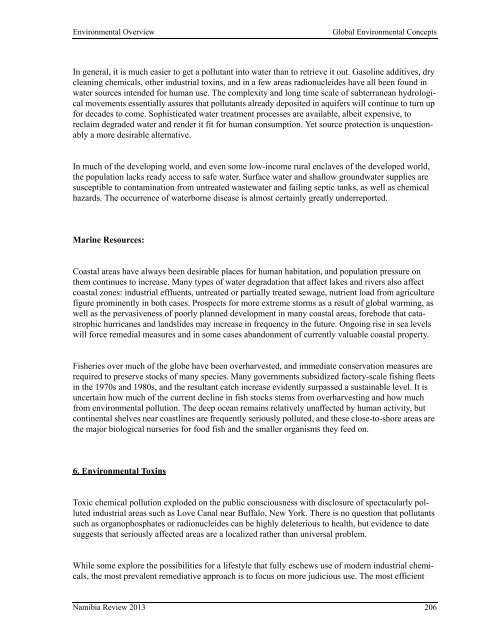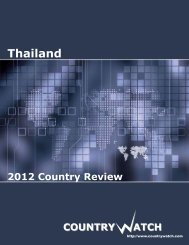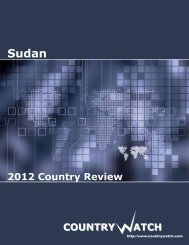Namibia - CountryWatch
Namibia - CountryWatch
Namibia - CountryWatch
Create successful ePaper yourself
Turn your PDF publications into a flip-book with our unique Google optimized e-Paper software.
Environmental Overview Global Environmental Concepts<br />
In general, it is much easier to get a pollutant into water than to retrieve it out. Gasoline additives, dry<br />
cleaning chemicals, other industrial toxins, and in a few areas radionucleides have all been found in<br />
water sources intended for human use. The complexity and long time scale of subterranean hydrological<br />
movements essentially assures that pollutants already deposited in aquifers will continue to turn up<br />
for decades to come. Sophisticated water treatment processes are available, albeit expensive, to<br />
reclaim degraded water and render it fit for human consumption. Yet source protection is unquestionably<br />
a more desirable alternative.<br />
In much of the developing world, and even some low-income rural enclaves of the developed world,<br />
the population lacks ready access to safe water. Surface water and shallow groundwater supplies are<br />
susceptible to contamination from untreated wastewater and failing septic tanks, as well as chemical<br />
hazards. The occurrence of waterborne disease is almost certainly greatly underreported.<br />
Marine Resources:<br />
Coastal areas have always been desirable places for human habitation, and population pressure on<br />
them continues to increase. Many types of water degradation that affect lakes and rivers also affect<br />
coastal zones: industrial effluents, untreated or partially treated sewage, nutrient load from agriculture<br />
figure prominently in both cases. Prospects for more extreme storms as a result of global warming, as<br />
well as the pervasiveness of poorly planned development in many coastal areas, forebode that catastrophic<br />
hurricanes and landslides may increase in frequency in the future. Ongoing rise in sea levels<br />
will force remedial measures and in some cases abandonment of currently valuable coastal property.<br />
Fisheries over much of the globe have been overharvested, and immediate conservation measures are<br />
required to preserve stocks of many species. Many governments subsidized factory-scale fishing fleets<br />
in the 1970s and 1980s, and the resultant catch increase evidently surpassed a sustainable level. It is<br />
uncertain how much of the current decline in fish stocks stems from overharvesting and how much<br />
from environmental pollution. The deep ocean remains relatively unaffected by human activity, but<br />
continental shelves near coastlines are frequently seriously polluted, and these close-to-shore areas are<br />
the major biological nurseries for food fish and the smaller organisms they feed on.<br />
6. Environmental Toxins<br />
Toxic chemical pollution exploded on the public consciousness with disclosure of spectacularly polluted<br />
industrial areas such as Love Canal near Buffalo, New York. There is no question that pollutants<br />
such as organophosphates or radionucleides can be highly deleterious to health, but evidence to date<br />
suggests that seriously affected areas are a localized rather than universal problem.<br />
While some explore the possibilities for a lifestyle that fully eschews use of modern industrial chemicals,<br />
the most prevalent remediative approach is to focus on more judicious use. The most efficient<br />
<strong>Namibia</strong> Review 2013 206




